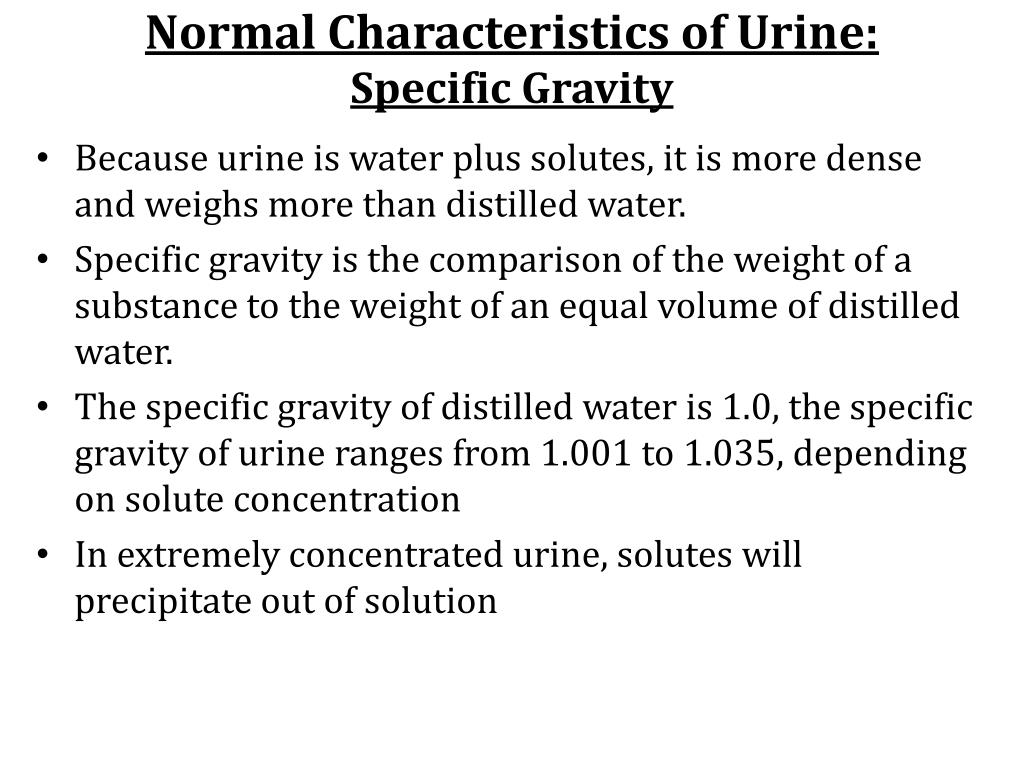

Further tests include urine culture and urinary electrolyte levels. Urinalysis involves the gross examination of urine, chemical evaluation using urine dipstick, and microscopic assessment of urine sediment. Malaria (especially Plasmodium falciparum).Malignancy (e.g., bladder cancer, renal cell carcinoma).Glomerulonephritis (see nephritic syndrome).Significant bacteriuria: ≥ 10 5 colony-forming units/mL in midstream urinary sample.Bacteriuria: presence of bacteria in urine.Glomerulonephritis (e.g., minimal change disease, focal segmental glomerulosclerosis).Occurs when blood glucose levels exceed 180 mg/dL (renal threshold for reabsorption of glucose).Urine osmolality similar to that of plasma osmolality.Loss of ability to concentrate or dilute urine due to damage to tubular cells.Findings that suggest appendicitis include nausea, fever, and pain at McBurney point (see appendicitis signs).


#Urine specific gravity range skin
Skin changes: can be indicative of an underlying systemic disease.Pulmonary edema : can indicate volume overload due to renal injury with low urine output.Pericardial friction rub : See “ Uremic pericarditis.Hypertension: can be an extrarenal manifestation of kidney injury.Nausea/vomiting: can be a sign of end-stage renal disease : or urolithiasis.Costovertebral angle tenderness : : characteristic of pyelonephritis.Persistent pain: indicative of inflammatory diseases (e.g., pyelonephritis ).Colicky pain radiating to the groin or genitals is most commonly seen in urolithiasis.Changes in urine and micturition : evaluate amount, frequency, appearance, and discomfort (see table below for details).The findings of these tests may be diagnostic or provide guidance for further diagnostic evaluation (e.g., renal biopsy, imaging)įor more on imaging and urodynamic tests, see “ Diagnostic investigations in urology.” For more on urine culture, see “Laboratory tests” under diagnostics in “ Urinary tract infections.” Current NBME laboratory reference values can be found under “Tips and Links” below.” History and physical examination The BUN/creatinine ratio and fractional excretion of sodium can be used to evaluate the cause of acute kidney injury. Inulin clearance and creatinine clearance provide the most accurate calculation of the GFR while serum creatinine can be used together with demographic data to provide an estimated GFR. Renal function testing involves a panel of parameters to assess for renal dysfunction.

Urine sediment allows for microscopic detection of cells, urinary casts, urinary crystals, bacteria, and yeast in a urine sample. Dipstick is a diagnostic tool consisting of a urine test strip that allows for quick assessment of potentially pathological changes of various parameters (e.g., pH, glucose, protein). Urinalysis helps to evaluate urinary abnormalities and involves gross assessment of urine, dipstick, and microscopy of urine sediment. This article covers important clinical findings of urological and renal conditions, including changes in micturition (e.g., dysuria, anuria) and changes in urine (e.g., hematuria, proteinuria) as well as the routine diagnostics for the initial evaluation of patients with urological and renal symptoms, including urinalysis and renal function testing.


 0 kommentar(er)
0 kommentar(er)
